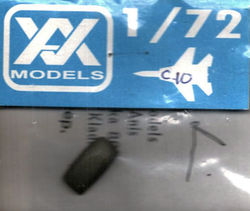A&V
MODELS 1-72 SCALE WW2 RAF SUPERMARINE SPITFIRE PR.Mk.X RESIN #AV010
----------------------------------
Additional Information from
Internet Encyclopedia
When development started on new
Merlin 60 powered Spitfires, both the Mk VII and VIII were to have
photo-reconnaissance (PR) variants. On 21 April 1942, an order was placed for
70 aircraft, provisionally designated PR Mk VIII. Based on the revised MK VIII
airframe these aircraft were to be powered by Merlin 61s and were assigned
serial numbers LV643–681 and LV726-756. The Spitfires bearing these serials
were eventually built as Merlin 66 LF Mk VIIIs.
A policy change resulted in the
pressurised PR variant of the Mk VII being renamed PR Mk X (type 387). This
version followed the PR Mk XI into production and was based on the Mk VII
airframe with PR Mk XI wings and camera installation. It had the pressurised Mk
VII cockpit, with the Lobelle sliding canopy, and retained the fighter style
windscreen with the bullet-proof glass panel. The long thin air intake to the
cockpit pressurisation system was fitted under the exhaust stacks on the
starboard cowling. The performance was similar to that of the PR XI although
the pressurised cockpit meant that this version could stay at altitudes of over
40,000 ft for longer without the exhausting physiological effects experienced
by the pilots of unpressurised cockpits. Sixteen Mk Xs were built during April
and May 1944, with the first mission being flown on 11 May. All saw limited
service in 541 Squadron and 542 Squadron for high altitude reconnaissance.
Experience with this version led to the development and production of the
pressurised version of the PR Mk XIX.
The Mk XI (type 365 standard,
type 370 tropicalised) was based on a combination of features from the marks
VII, VIII and IX. The Mk XI was the first PR variant to have the option of
using two vertically mounted F52 cameras with 36-inch-focal-length lens in the
fuselage behind the cockpit.[48] Several other configurations could be fitted,
depending on the mission; the X Type installation, for example had two
vertically mounted F24s with 14-inch lens and an oblique F24 with an 8-inch
lens mounted above and facing to port. PR Mk XIs used for tactical
reconnaissance had an additional, vertically oriented camera in a fairing under
each wing.
Physically the Mk XIs had a
deeper nose fairing to accommodate a larger 14.5 gal oil tank and used the
unarmoured, wrap-around PRU windscreen. Booster pumps for the wing tanks were
fitted and covered by teardrop shaped fairings under the wings. Retractable
tailwheels were fitted as standard and the majority of the Mk XIs built had the
later large-area pointed rudder. 260 Mk XIs were powered by Merlin 61, 63 or
63A engines, while the remaining 211 used the high-altitude Merlin 70. All of
the Merlin 70 and 198 of the Merlin 60 series aircraft were fitted with the
Vokes Aero-Vee dust filter in the extended, streamlined carburettor air intake
under the nose. All Merlin 60 powered aircraft featured the fuel cooler in the
port leading edge wing root. The radio installation was either the VHF TR.1133
or TR.1143 fitted with the "Rebecca" beam approach equipment.
Additional slipper drop tanks
could be fitted under the centre-section; in common with the Mk IX these could
be 30, 45 or 90 gal capacity and, for the Mk XI, a tank of 170 gal capacity was
also available.[38]
Spitfire PR Mk XIs were capable
of a top speed of 417 mph (671 km/h) at 24,000 ft (7,300 m) and could cruise at
395 mph (636 km/h) at 32,000 ft (9,800 m). Normally Spitfire XIs cruised
between these altitudes although, in an emergency, the aircraft could climb to
44,000 ft (13,000 m) However, pilots could not withstand such altitudes for
long in a non-pressurised cockpit without suffering from serious physiological
effects.
At first, production of the PR
Mk XI was delayed because development of the Mk VII and VIII series was
delayed. As a result, it was decided to base the Merlin 60 powered PR aircraft
on the MK IX airframe.[45] Production was further threatened because of a
dispute over RAF PR doctrine: in early 1943, because the new PR Spitfire was
delayed, the Air Ministry proposed that all PR units be converted to de
Havilland Mosquitoes. After further analysis the Air Staff agreed that
Mosquitoes could perform 90% of PR missions so the Spitfire production for only
10% of PR units was mooted. Air Vice Marshal John Slessor, head of Coastal
Command pointed out that the Spitfire was smaller than the Mosquito, used half
the number of Merlin engines and was faster, more manoeuvrable and quieter and,
therefore production should be increased, not reduced. As a result, the Air
Staff decided that PR Mk XI production should be accelerated at the cost of the
fighters.
The first Mk XIs were built in
November 1942: from April 1944 production ran concurrently with the PR Mk XIX
before ending in December 1944, when they were phased out in favour of the Mk
XIX. In total 471 Mk XI were built by Supermarine.





